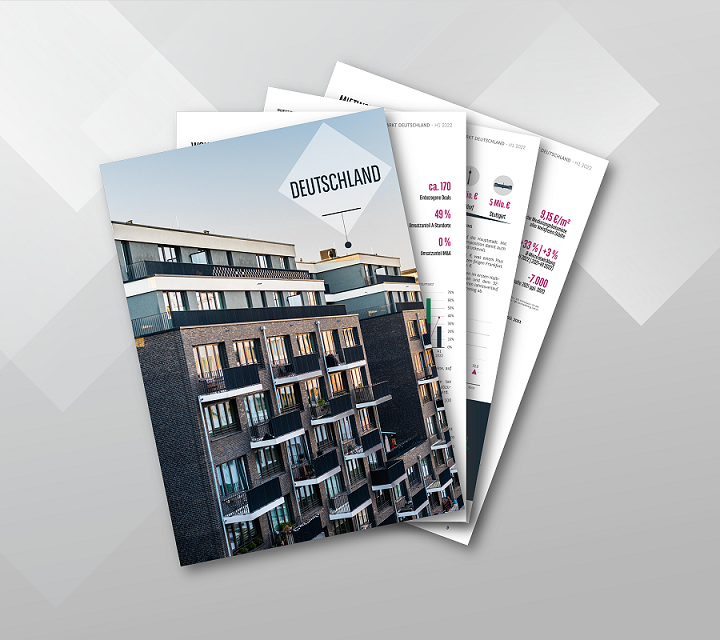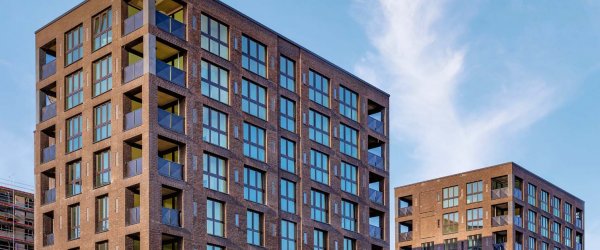Trends and insights of the residential market in Germany
The underlying conditions on the economic and capital markets have fundamentally changed in the past year. Likewise, the realities for housing markets have altered dramatically. The Russian war, supply chain bottlenecks and the post-Corona recovery led to a sharp rise in inflation.
CONTENTS AT A GLANCE
-
Prologue [»]
-
Residential investment market Germany
-
Rental housing market Germany
-
Market data on major German cities
-
Factsheets on 110 cities

FUNDAMENTAL CHANGES FOR THE HOUSING MARKETS
-
The underlying conditions on the economic and capital markets have fundamentally changed in the past year. Likewise, the realities for housing markets have altered dramatically. The Russian war, supply chain bottlenecks and the post-Corona recovery led to a sharp rise in inflation. To counteract this, in 2022 the ECB raised interest rates sharply four times, each time by 50 or 75 basis points. As a result, financing costs for real estate investments have risen considerably. For example, new mortgage loans issued by banks to private households (fixed interest rates over 10 years) rose by an average of 310 basis points from January (1.3%) to December (4.3%). This is also strikingly reflected in the demand for mortgage loans: While new business volumes for mortgage loans on fixed interest rates over 10 years still ranged between € 12.2 and 15.8 billion per month between January and March, new business dropped significantly to only about € 4.8 billion in December.
FINANCIAL BURDEN OF BUYING PROPERTY OR RENTING DIFFERS GREATLY
-
The sharp rise in financing costs was not only felt by institutional investors. An average private household in A-cities can hardly afford the financial burden of purchasing a new apartment (80 m²). With debt financing (full financing incl. additional acquisition costs, 2 % repayment), the average monthly cost in 2022 was 35.10 €/m². Usually, 30 % of household income for housing is considered a financially affordable limit. Calculated with 80 m², this corresponds to around 16.20 €/m².
-
Between 2015 and 2021, the financial cost of buying property was between 3.00 and 6.10 €/m² higher than the cost of renting. In 2022, the difference between buying and renting (at 17.80 €/m²) has become significantly greater. This means that in the new-build segment, there is virtually no alternative to living in rented accommodation (a good 17 €/m²) for households with average purchasing power.
SHARP RISE IN LAND AND CONSTRUCTION EXPENSES ARE ADDITIONAL COST DRIVER
-
Land prices, which have risen sharply in recent years, are a significant cost driver for new construction. While land costs in major cities increased by around 62% between 2015 and 2022, they more than doubled (+147%) in A-cities compared to 2015.
-
Construction, which makes up the largest single expense in new housing, has also risen by around 57% compared to 2015. Especially compared to 2021, the average construction costs for a standard apartment have risen particularly sharply, by +16% to currently €4,070 per m² of living space. Together with the sharp rise in land costs, especially in the A-cities, the total costs of new builds have experienced a considerable price increase. The new, revised circumstances (persistently high material and energy prices as well as rising wage costs) make a (significant) decline in production costs in the coming years appear very unlikely.
ECONOMIC RENT SIGNIFICANTLY EXCEEDS ASKING RENT FOR THE FIRST TIME
-
This backdrop of changes behind the purchase of owner-occupied apartments, arising from the significantly increased financial burden and the resulting shift in supply from prospective buyers to the rental housing market, once again brings into question the economic profitability of new construction in the rental housing market. The economically viable rent for project developers is made up of land and construction costs (incl. risk & profit). In recent years, this has been calculated to be between 14.70 €/m² (2016) and 16.10 €/m² (2021) in A-cities.
-
Economically viable rent was close to asking rents in 2016 and just below them between 2017 and 2021. Construction of rental apartments was therefore profitable in these years. In 2022, however, the circumstances fundamentally changed. For new construction in the A-cities to remain profitable, an average rent of 21.70/€m² would have to be envisaged. Rents on the market in the past year were significantly lower at around 17.90/€m² (mean average).
-
While this calculation remains quite model-like, as it is based on average land costs, production costs and asking rents, it nevertheless illustrates the need for further increases in rents for privately financed new housing construction. The current high economically viable rent makes it difficult for project developers to work profitably.
DECLINING BUILDING PERMITS AND HOUSING CONSTRUCTION ORDERS
-
The dilemma of higher financing costs on the one hand and significantly increased land and construction costs on the other caused a significant weakening of demand from both institutional and private investors. Lower demand is reflected in the number of approved residential units. For 2022 as a whole, building permits were most probably close to the average of recent years (around 336,000). However, since September 2022 at the latest, there has been a steady monthly decline in building permits.
-
The number of residential units completed also declined to well below 300,000.
-
The decline in the number of building permits was already evident in the order books in the construction industry much earlier in the year. For example, a decline in orders for residential construction was already recorded every month since April 2022.
EXCESS DEMAND IN THE RENTAL HOUSING MARKET CONTINUES TO RISE
-
In 2022 the Federal Government's target of 400,000 constructed residential units will again be missed by a wide margin.
-
The decline in building permits and orders in residential construction in the course of last year, as well as the postponement or cancellation of some construction projects (especially in early construction phases), led to a further increase in the construction backlog (approved but not completed projects).
-
An improvement in supply is therefore not foreseeable in the short term (if same conditions persist).
-
In addition to the shifts from ownership to renting outlined above, demand will be particularly stimulated by a projected population growth in highly desirable German cities and student-towns up to 2035, as well as a considerable surge in demand due to people fleeing the war. Furthermore, the trend towards smaller households is likely to continue. Overall, a further increase in household numbers is to be expected.
FURTHER ROBUST RENTAL PRICE GROWTH EXPECTED
-
Further declines in construction completions, additional demand from refugees and a definite shift in demand from the owner-occupied housing market to the rental housing markets suggest that rental prices will continue to rise in the medium term.
-
In the short term, high inflation and the sharp rise in energy costs are likely to dampen further rent growth. Currently, however, initial secondary effects are already emerging, driven by significantly higher nominal wage demands and increases. This means that housing affordability should not deteriorate, provided rents do not outpace wage increases.
-
However, it is likely that in the coming years there will be more differentiation in the development of rents between different locations and market segments than has been the case so far. Supply bottlenecks will become more entrenched, especially in sought-after large and booming cities, so rents can be expected to rise in the medium term as well. However, the highest rent increases in 2022 were observed in medium-sized cities, both in the existing stock (+4.9%) and especially in new construction (+8.1%). Though it remains to be seen whether these signs of catch-up effects will continue in the future.
RESIDENTIAL REAL ESTATE REMAINS AN ATTRACTIVE ASSET CLASS
-
It cannot be ruled out that in the foreseeable future the trend towards higher residential space consumption will be reversed due to significantly rising rents and that the affordability of housing will be improved via lower space consumption.
-
The price discovery phase in the residential real estate market is still not over. It should be noted that apartments are still an attractive investment for both private and institutional investors. This is supported by the ongoing surplus of demand, the greater potential for rent increases and a certain degree of inflation hedging.
KEY TAKEAWAYS
- Conditions on the capital markets have fundamentally changed in 2022. Significantly increased financing costs, soaring construction expenses, further increases in the price of land, strong growth in energy costs and high inflation mean a mixed bag of new challenges for all market participants.
- The weakening demand in the owner-occupier apartment market is reflected in significantly declining volumes of mortgage loans to private households as well as steadily declining building permits and construction order books over the course of the year.
- For many average private households, there is no alternative to renting, at least in the new-build segment. The purchase of new-build apartments is no longer affordable for households with average purchasing power (and little equity).
- Sharply increased construction costs and further rising land costs imply an economically viable rent for project developers is significantly higher than the 2022 asking rent in A-cities.
- Excess demand in the rental housing market will continue in the medium term due to ongoing population growth and increased financing costs. Rents are likely to continue to rise, albeit more differentiated by region, location, and segment than in the past.
- Stable cash flows and foreseeable potential for rent increases continue to make apartments very attractive assets.
Download
Would you like to read the entire Residential Report? Please register using our form. We will then send you the entire Residential Report by e-mail.
